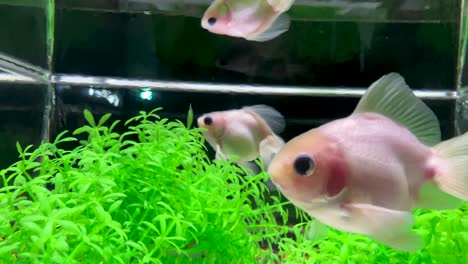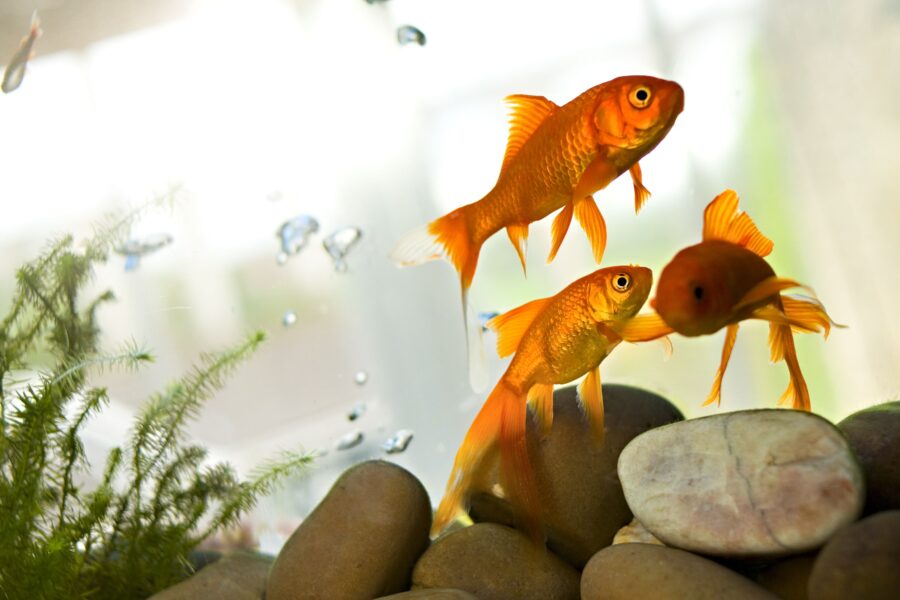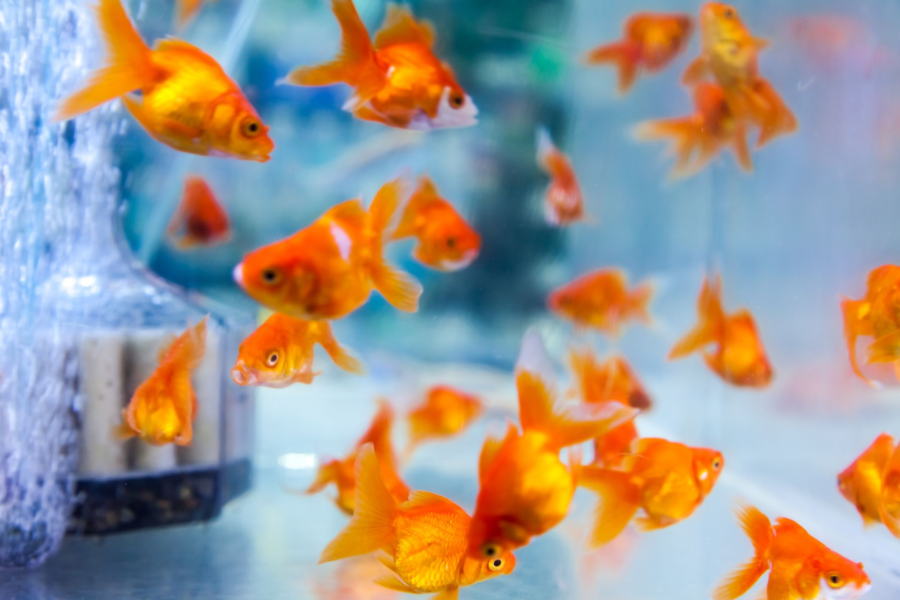
Ever felt like a goldfish swimming in a vast ocean of substrate information? Look no further! This handy dandy guide is your lifeline to understanding the ABC’s of substrates, specifically when you’re in the business of pleasing goldfish.
We’ll dive deep into the nuances of different substrate types and reveal the perfect ‘gravel’ personality match for your gilled friends. Crunchy details about how substrates influence our finny pals and key considerations for your goldfish tank await. So, buckle up, it’s about to get ‘substra-ting’ fun!
Understanding Substrates

Take it from a fish-loving writer: substrates aren’t as scary as they sound. They’re just a fancy term for the stuff you see at the bottom of your aquarium. It could be sand, gravel, pebbles. So sit tight and let’s dive in!
Defining Substrates
In the simplest terms, substrates are the material at the bottom of an aquarium. I like to call it the “underwater carpet.” (Who said fish can’t have rugs, huh?) It’s more than just aesthetics, though, as substrates can also improve water quality and provide a more natural habitat for your fish.
Different Types of Substrates
When it comes to substrates, there’s a smorgasbord of options. You’ve got your gravel, sand, crushed coral, even marbles! Don’t get too carried away at that pet store though, not all substrates are created equal and picking the wrong one can be like choosing stilettos for a marathon. But I’ll save that juicy topic for the next part of our conversation.
Hang on to your fishnets, we’re about to venture into the world of goldfish and their relationship with substrates. Will it be a match made in heaven like peanut butter and jelly, or more of a disaster like oil and water? Spoiler alert: it’s a little bit of both!
The Relationship between Goldfish and Substrates

Let’s dive right in and talk about our gilded friends and their interactions with substrates.
Natural Habitats of Goldfish and Presence of Substrates
In the nautical neighborhoods where goldfish hang out – think ponds, slow-moving rivers, and lakes – substrates are common. These underwater abodes are carpeted with sand, gravel, and other organic matter that we classify as substrates. These do more than just give the place a cozy, lived-in look. They provide a habitat for beneficial bacteria and feed the ecosystem’s needs. Introducing these substrates into your aquarium not only mimics their natural habitat but also plays a significant role in maintaining their health. For a deeper dive into the matter, check out The Importance of Substrates for Goldfish Health. So, bringing a bit of that earthy goodness into your tank could be like giving your goldfish a taste of home – don’t be surprised if they start humming ‘Sweet Home Alabama’!
Goldfish’s Behavior with Substrates
Ever observed how goldfish seem to share a fondness for substrates? It’s not just because they make a nice seabed for their naps. Goldfish love to root around in substrates, akin to your dog burying his treats in the backyard. This behavior also aids in the breakdown of waste products, effectively keeping the tank cleaner. However, watch out for a pebble-munching goldfish. Smaller substrates can be a choking hazard!
Now that we’ve painted a picture of the goldfish-substrate love story, you might think that it’s a match made in aquatic heaven. But, as reality dating shows teach us, there’s always a downside. If you’re keen on getting into the nitty-gritty, you can dive into Substrates for Goldfish Tanks: What You Need to Know. As we swim into the next section, brace yourself for the full story, complete with the pros and cons of using substrates in a goldfish tank.
The Pros and Cons of Substrates in a Goldfish Tank
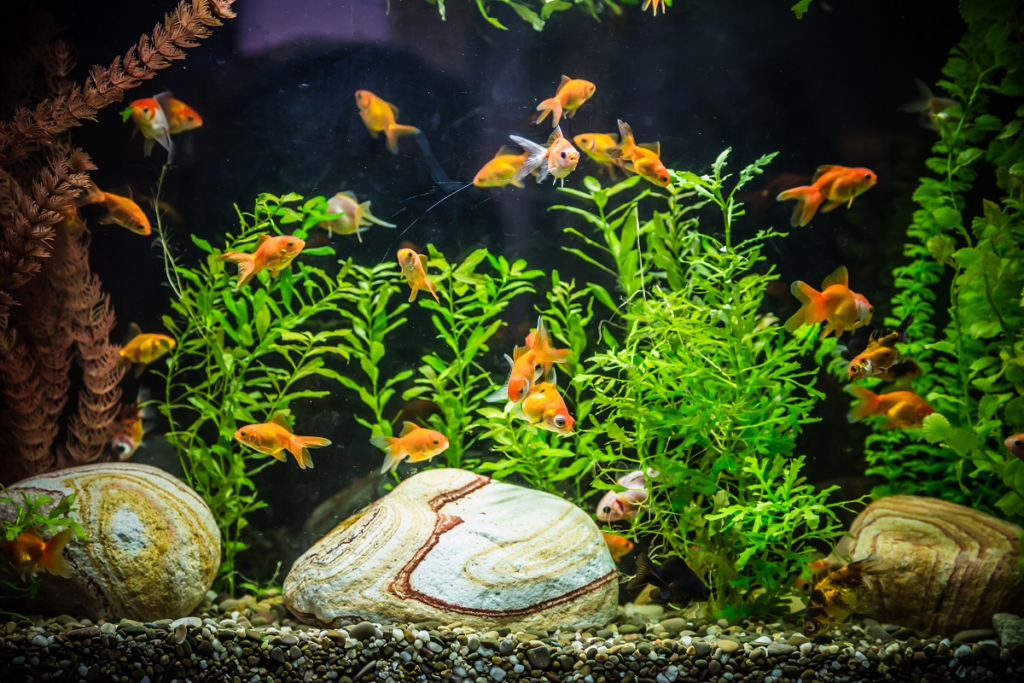
Let’s wade into the world of substrates. We’ll explore the good, the bad, and the murky bits of using these elements in your goldfish’s abode.
The Glittering Advantages of Using Substrates
Imagine dropping a goldfish into a bare, sterile fish tank. No gravel, no plants, just water. It’s like throwing a party and forgetting the… well, party. Substrates like gravel, sand, or pebbles not only jazz up an otherwise dull tank but also creates a more natural environment.
Substrates house good bacteria, which helps with biological filtration. This magic stuff breaks down harmful compounds like ammonia before it becomes a problem for your fishy friend. Plus, some goldfish like to play hide-and-seek and forage at the bottom. Substrates make it a fun playground for them. It’s like an all-you-can-eat buffet that also doubles as a theme park.
The Slippery Downsides of Using Substrates
But like any good ying-yang relationship, substrates also have a darker side. Improper maintenance of substrates can lead to build-up of decaying organic material. This can harm your goldfish and turn your tank into a stinky mess. It’s like forgetting to take out the trash for a week. Yuck!
Also, some substrates can change your water’s pH level, which isn’t always good news for your goldfish. It’s like suddenly changing their favorite tune to a screeching death metal song. Not appreciated!
Don’t rest your fins yet. Before you make your decision on substrates, drift onto the next section where we will shed light on how to pick the best substrate for your goldfish. Trust me, picking a substrate is like dating; it’s a matter of finding the right match. Excited yet? So, what are you waiting for? Dive right in!
Choosing the Best Substrate for Your Goldfish

Just like you wouldn’t live in a house you didn’t feel comfortable in (think haunted mansion or an igloo), your goldfish don’t either. And that’s why picking the right substrate — their home sweet home — is crucial.
Factors to Consider When Choosing a Substrate
Size matters — just ask your goldfish. If the substrate particles are too large, they may feel like they’re walking on hot coals (and that wouldn’t be fun). If too small, the particles can get stuck in their gills. Not cool, right?
Color choices. Now you might think, “Goldfish don’t care about colors, right?” Surprisingly, some goldfish owners swear that their pets become more vibrant with dark-colored substrate. It’s like giving their world a little kick of feng shui.
Chemical reactions are not your friend. Stay away from substrates that can alter your tank’s pH level. It’s like suddenly changing the weather from sunny beach to freezing tundra. Not cool.
The key takeaway here? Always consider your goldfish’s comfort and safety above aesthetic appeal. It’s like choosing a house. You wouldn’t compromise on a safe neighborhood for a fancy view, right?
Recommended Substrates for Goldfish
Small or Smooth-edged gravels: Gravels aren’t just pretty – they’re practical. Just like a sturdy pair of boating shoes. They’re safe for your goldfish and keep crud (dead plants, waste) from getting out of control. For a curated list of top picks, see our article on 5 Best Gravels for Goldfish Tanks.
Sand: Think of the joy you feel when walking on the beach. That’s how your goldfish might feel about sand. It’s smooth and natural and replicates the bottom of rivers or ponds, making it another goldfish-approved choice. Get the scoop on top sands with our 5 Best Sands for Goldfish Tanks guide.
Marbles or pebbles: Marbles or pebbles are like the upholstered stools of the goldfish world. Stylish, but a bit impractical. They don’t trap waste, making tank cleaning a bit tricky.
Essentially, the choice of substrate comes down to striking a balance between the goldfish’s needs and the ease of upkeep. If you’re aiming for a comprehensive look into substrates of various dimensions, don’t miss out on our article 5 Best Substrates for Goldfish Tanks of All Sizes. Your goldfish might not hand over a ‘thank-you’ card for making their tank cozier, but their bright, healthy colors and delightful friskiness will be thanks enough.
Ready to dive into the next section? We’re going to share some pro-level tips on how to use and maintain substrates, so your goldfish can live happily, and you can breathe easier knowing you’ve done the best for your aquatic pals.
How to Properly Use and Maintain Substrates
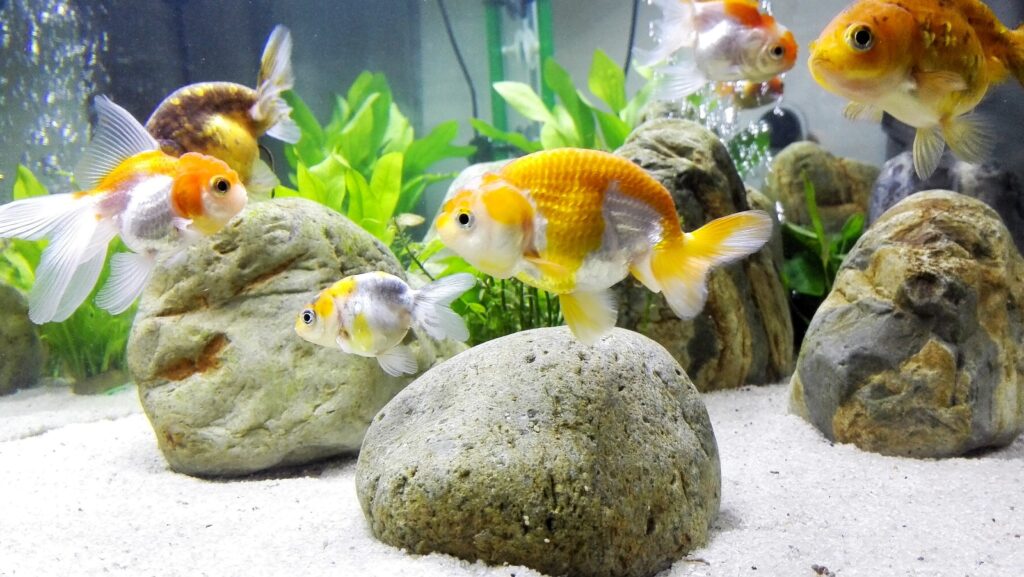
We’ve been through the highs and lows of using substrates in a goldfish tank, it’s about time we learn how to properly use and care for them. Just like dating, the secret to a healthy relationship with substrates lies in how you handle them. So, roll up those sleeves and prepare to learn the art of substrate maintenance!
Proper Installation of Substrates
First things first, to ensure your goldfish’s soiree with substrates is a hit, installing correctly is crucial. Start by thoroughly rinsing the substrate in fresh water, removing any dust and loose particles (this isn’t a smoke machine party, people!).
Next, gently introduce the substrates to the tank and spread evenly at the bottom. Remember, doing this pre-water is your best bet to avoid a dusty rave in your tank. The rule of thumb is a layer about 2 inches deep. It’s like putting down a comfy rug for your goldfish.
Cleaning and Maintenance of Substrates
Remember, “Cleanliness is next to Goldfish-ness!”. To maintain substrates, you’ll need to periodically clean them. Get your hands on a good gravel cleaner and send those pesky dirt particles on a one-way trip out of your tank! Depending on your substrate type, you may also need to shuffle them once in a while to prevent toxic gas pockets. Yeah, isn’t it strange that you’re the one doing housekeeping for the fish?
The key takeaway? Take care and your goldfish-substrate relationship will flourish, leading to both a happier fish and a stunning tank. But, toss care to the winds and you might end up in a mucky mess (literally!).
Need a detailed guide on this? Check out our Guide to Keeping Goldfish Substrates Clean and Healthy for a deeper dive into maintaining a pristine habitat.
Up next, we’re going to be diving into one last tank with our goldfish (not literally, of course). Stay put as we explore common substrate-related missteps and how to sidestep them before you even get your feet wet. Join me in the next section “Common Mistakes to Avoid When Using Substrates”. You didn’t think we’d leave you to navigate the murky waters of substrate selection solo, did you?
Common Mistakes to Avoid When Using Substrates
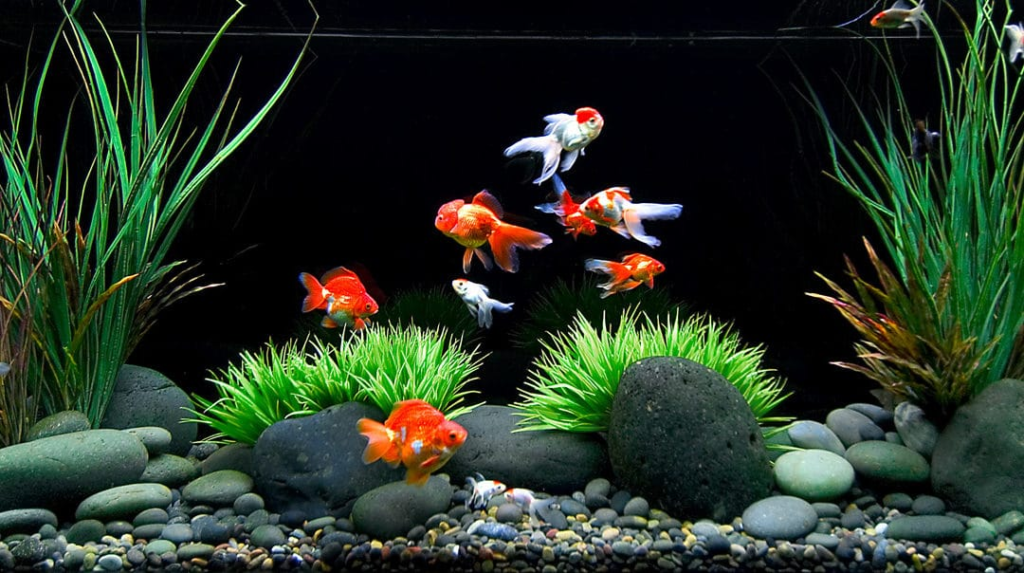
Effing up your goldfish’s cozy digs is never cool. So let’s talk common slip-ups that can turn your fishy’s paradise into a sand-filled hellscape.
Not Cleaning Substrates Regularly
Let’s play a game. It’s called “What Do Substrates and Teenage Bedrooms Have in Common?” The answer: both can get dirty fast! Believe it, my friend, if substrates aren’t cleaned properly, they start housing extra nitrates and phosphates. It’s like a hotel for harmful substances. Your goldfish doesn’t need a stinky, filth-filled vacay spot. So, clean the substrate often. Their health relies on it.
Choosing the Wrong Size or Type
There’s more to substrates than meets the eye. Just like you wouldn’t put on ice skates for a sandy beach, you can’t just dump any old substrates into a goldfish tank. Small substrates can cause choking issues for your flippery pal. On the other hand, sharper, bigger substrates can give your pet rock-hopping bruises. Bummer, right? So, get the right size and type. Goldfish plus wrong substrates equals bad news.
Ah, that brings us to the end of our rendezvous in the undersea world of goldfish substrates. Remember to keep these common mistakes in check or your fishy friends might be swimming towards the pearly gates faster than you’d like.
To Sum Up
It’s clear that the relationship between goldfish and substrates is an important one, deeply rooted in their native habitats. Careful selection of substrate, guided by understanding their pros, cons, and impact on goldfish, is pivotal. Considering factors like size, type, and your ability to maintain it can make a big difference in your tank’s ecosystem.
Mishaps in substrate use are common, but easily avoidable if you’re armed with knowledge. Regular cleaning and the correct installation of substrates can prevent many problems. So, remember, knowledge is power and could be the difference between a thriving goldfish and a fish out of water. In summary, when it comes to goldfish and substrates, you’re now a well-informed, substrate savvy fish owner.
Frequently Asked Questions (FAQ)
Question: What are substrates?
Answer: Substrates are any materials used at the bottom of a fish tank. This can include sand, pebbles, or gravel.
Question: Do goldfish require substrates in their tanks?
Answer: While it isn’t mandatory, substrates can help replicate a goldfish’s natural environment and improve the water’s quality, making it a healthy choice.
Question: What are the benefits of using substrates in a goldfish tank?
Answer: Substrates offer benefits like bacterial growth promoting water quality, prevention of waste buildup by providing a surface for beneficial bacteria to thrive, and aesthetic enhancement of your tank.
Question: What are the drawbacks of using substrates in a goldfish tank?
Answer: Substrates can sometimes trap food and waste, leading to poor water quality if not cleaned regularly. They can also be a choking hazard for goldfish who like to sift through the bottom materials.
Question: How should I choose the best substrate for my goldfish tank?
Answer: Consider factors like your goldfish’s behavior, the type and size of substrate, and ease of cleaning when choosing the substrate for your tank.
Question: How do you maintain substrates in a goldfish tank?
Answer: Maintaining substrates involves regular cleaning to remove trapped waste. You can use a siphon to clean without removing the substrates from the tank.
Question: What are some common mistakes to avoid when using substrates?
Answer: Some mistakes to avoid include not cleaning the substrates regularly and choosing the wrong size or type, which can potentially harm your goldfish.

